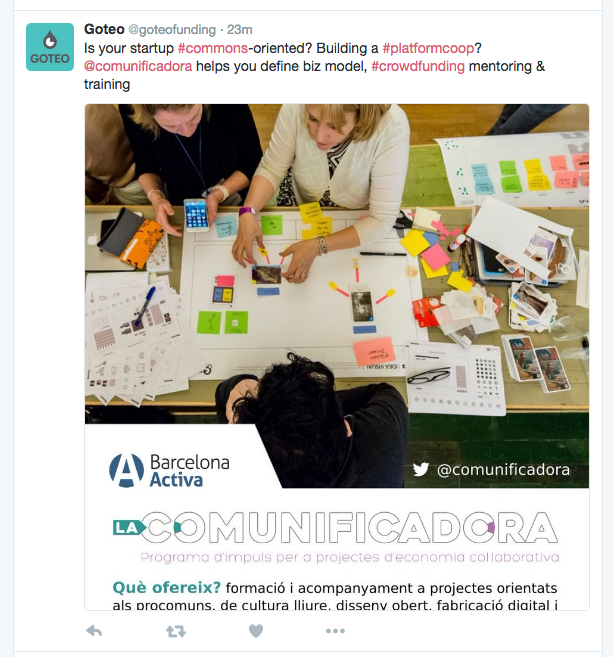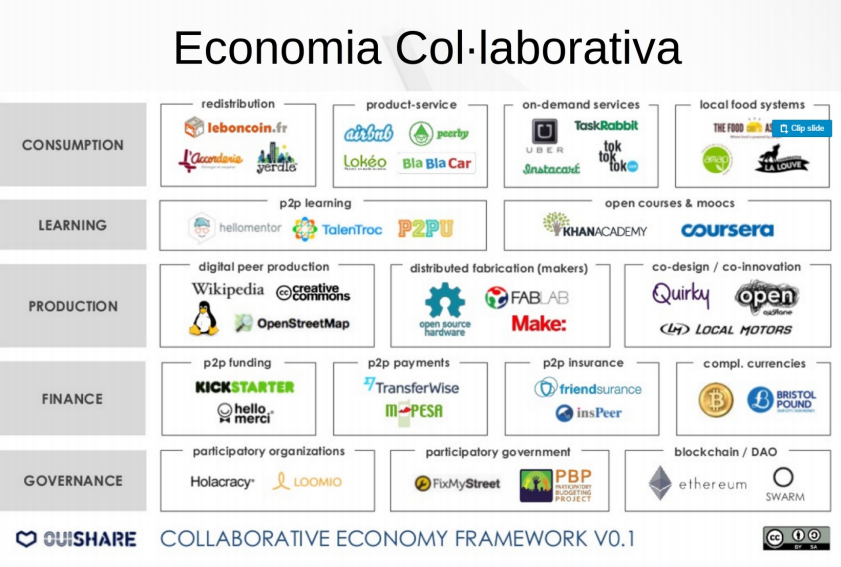Last week the new collaborative economy support programme, La Comunificadora (the “Commons Makery”), was launched at an open session in the Convent de Sant Agustí (Barcelona).
 Several projects with the potential to participate in the support programme were presented in the session. Among them was the idea of creating a special currency for co-working spaces, an initiative for citizens to rent out their kitchens, a money-free platform to exchange goods and services, a child raising association, a food printer, and an advisory platform for open hardware designs. There were also already existing projects seeking to become sustainable, including a cooperative sharing electric cars, an initiative to produce a water filter for developing countries, a workshop for a DIY plastics recycling, and a health services cooperative. And someone even came with a project to replicate La Comunificadora! Everyone was eager to know the contents of the programme.
Several projects with the potential to participate in the support programme were presented in the session. Among them was the idea of creating a special currency for co-working spaces, an initiative for citizens to rent out their kitchens, a money-free platform to exchange goods and services, a child raising association, a food printer, and an advisory platform for open hardware designs. There were also already existing projects seeking to become sustainable, including a cooperative sharing electric cars, an initiative to produce a water filter for developing countries, a workshop for a DIY plastics recycling, and a health services cooperative. And someone even came with a project to replicate La Comunificadora! Everyone was eager to know the contents of the programme.
This session was an introduction to the collaborative and sharing economy and the economy of the commons, presenting case studies to extract the principles of the open source code production and apply them to other sectors. What is sought here is specifically how to align the interests and motivations of producers and consumers to create fairer economic relationships. The session established the grounds for the five modules of the programme.
Collaborative economy production models

‘Collaborative economy’ entails circulation and cooperation among users. It is a relatively recent concept, not even ten years old, but it already has several versions in keeping with the broad framework suggested by the OuiShare (sharing economy) festival.
There are three main collaborative economy production models: 1) within the organisation (intra-firm), 2) in the market, and 3) P2P production. As early as the 1990s Professor Yochai Benkler was talking about this third model. The P2P or peer production model is considered to be the basis of what we now call the collaborative economy: value is not only created in the company or the market, but also in cooperation between different users through an online platform.
Within P2P Projects:
A first model would be Wikipedia which, although it is in the digital peer production block, is not only P2P production but its platform is open source and its governance is distributed. Along similar lines to Wikipedia are GNU/Linux, Openstreetmap and other projects where the production of a common good goes together with open-access community organisation.
A second model would be initiatives of distributed production where rules of online cooperation are used in digital generation of tangible goods, incuding FabLabs, hackerspaces and makerspaces in general.
In the third mode, P2P Production, transaction and opportunity costs decrease, thanks to the Internet.
Commons Based Peer Production means that P2P processes often give rise to the production of a common good, and consequently offer an alternative economic model, as studied in great detail by Michel Bauwens and his global network of P2P researchers (P2PFoundation.org)
Elinor Ostrom described the relationship between the market, the state and the commons, showing that communal resources have rules, more or less formal and complex, which allow for sustainable management and avoid the so-called ‘tragedy of the commons’.
“Commons are inherited or created gifts that we organise, use and store in our lifetime through informal practices and rules which we pass on to future generations” James Quilligan (Global Commons Trust).
There is a series of elements that digital and natural goods have in common:
- Self-management
- Accessible membership
- Knowledge needs to be, at least, shared. While knowledge is not always public we make it public over the Internet.
- Everyone can use them and copy them easily.
These processes are already occurring, informally, in cooperatives and consumer groups, but they need to be formalised so that people can participate, contribute, fork and copy.
The classical example of digital commons is the Free Software Movement (also known as Open Source Software). In the 1980’s, Richard Stallman, founding father of the Free Software Movement, made a commitment to give access to the software he was developing, to everyone as long as they respected the four freedoms: use, adapt, copy and share, and distribute.
Hundreds of examples of P2P platforms are collected in the P2PValue.eu study, they include: collaborative research projects, hacklabs, open design, cooperative mapping, open data, social currencies, community telecom networks like guifinet, etc.
Jeremy Rifkin, economist, strategist, visionary, adviser to many governments and organisations, says the end of capitalism and the rise of collaborative commons have arrived. In a world where Internet of Things (IoT) connects everything and people can participate in the production and consumption of goods, the cost of production will decrease. The zero marginal cost society is here. It’s almost already occurring in the case of digital goods. Paul Mason, from the perspective of economic history, talks about postcapitalism.
Motivations
In this context it is important to take into account the motivations each person has to produce common goods and services, They are often similar to those of Free Software developers:
– Economic motivation: In free software (free as in freedom) there are no licences sold but services around the software are offered, like customisation, training, installation etc, or in other words: services of added value. There can be monetary returns, low opportunity costs, a reputation or status created, and professional benefits.
– Social motivation: To help others, to feel part of the community, the activist fight for a cause, to have fun, for altruism, …
– Technological motivation: A desire to know and learn about technology, and to overcome technological challenges.
Replicating and viability
In every community we work with we need to know and understand why people want to participate. Because if what we produce is replicable at zero marginal cost (which is a feature of open and free projects) how do you make the project economically viable?
There are several models. We have summarised them in an Open Business Model identifying the four most important pillars. Based on this model it is possible to analyse several aspects that intervene in the creation of value, revenues and economic sustainability. Each project can then decide what options to take in relation to each pillar.
- Licencing (for software, artwork, design, and documentation) can be copyleft, permissive, copy fair, non-commercial, non-derivative, all rights reserved.
- Revenue models based on added value services, selling a hardware product based on a digital design, matchmaking platforms, and membership fees (such as in the eXO Association, at guifi.net).
- Modes of production, for example intra-firm, through the market or peer production, with lower costs.
- Governance models, with legal entity, membership politics, value distribution, co-budgeting, replicating.
There is a certain mismatch between corporate business models and all of the interests involved, here they favour some in detriment of others, which are exploited or damaged.
Here, it is important to align all of the pillars so that interests and motivations of producers and consumers are balanced and in synch, so that fairer economic relationships may be created. This is about having the user at the centre and linking him or her up with technologies, legal aspects, existing communities, groups that are already based on P2P production, and specific business models, which will be studied in this programme.
In fact, we are in a transition. The key is most probably in cooperation among initiatives that share ways of functioning and goals. We can find many answers in the “platform cooperativism” concept, coined by Trebor Scholtz in 2015.
All of this is happening under the umbrella of the department of “Other Economies and Entrepreneurism” at Barcelona Activa (Barcelona City Council), when this institution is firmly committed to integrating the concept of technological sovereignty into the digital transformation of the public sector.
The programme
Five training modules (45h) with individual mentoring (10-15h) by project leaders/teams. The programme includes working with other projects, face-to-face meet-ups, and online collaborative work.
Training modules:
- Module 0: open session, prior to selection of projects (1 session): introduction to the programme and the collaborative or sharing economy, the economy of the commons, open business models, principles and case studies
- Module 1 (1 session): business and sustainability models; knowledge management, open and free licences, governance and production models
- Module 2 (2 sessions): free-as-in-freedom and collaborative tools, their ecosystems and networking (digital platforms, management tools, Internet of Things, digital fabrication, blockchain, DAO)
- Module 3 (2 sessions): co-creation workshop, generating a business model appropriate for the selected project, using the Wotify toolkit
- Module 4 (1 session): Types of legal entities, economic management and platform cooperativism.
Group mentoring module:
- Module 5 (1 session): Financing. Resources for obtaining economic support. Crowdfunding workshop; case studies and planning campaigns for projects in the programme.
Individual mentoring:
Working with tutors, each project will define a mentoring plan with one or more mentors according to needs.
La Comunificadora is a programme from Barcelona Activa produced by Platoniq, Goteo Foundation and the Free Knowledge Institute, with a large group of people and organisations working for the collaborative economy, free culture and commons movements. Barcelona Activa is Barcelona’s local development agency with a wide range of services for startups and entrepreneurs.
La Comunificadora answers for a programme focused on the economy of the commons lacking until now.
